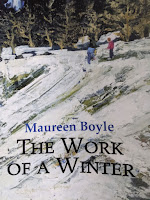Today's poem
THE WORK OF A WINTER by Maureen Boyle
This collection is different from most of what I have recently read so far. Different from works by immigrants. In this sense, the book is dissimilar to those for me. The main stage is Belfast, broadly, Northern Ireland. Garden and winter are keywords throughout the collection. From poem to poem, her religious feelings and sensitivity are embedded in various forms. Further, in gardens, winter means a kind of death, waiting for seasonal change, i.e., spring as rebirth.
The opening verse is a sequence of poems in memoriam of her father. The first poem in the sequence Latin-entitled ‘INCUNABULA’ implies the beginning and end of his life. The poems are portrayals of Northern Ireland’s history and her daily life, nature, and religion. From ‘INCUNABULA’, one of poems that stood out for me was ‘VII’ showing summer pleasure in her childhood where Enid Blyton was picked up. Enid's works have been popular in Japan, therefore it’s familiar to me, too.
I was interested in verse on Hildegard von Bingen, Yasunari Kawabata, photography (Richard Avedon), haiku, etc. I could enjoy reading the works. In particular, the poem ‘NUREYEV’ was written as tracing the ballet dancer Rudolf Nureyev’s life and it was impressive to me, for it reminded me of the photography collection Ballet by my favorite Richard Avedon’s teacher, Alexey Brodovitch.
And the quatrain ‘THE RABBI AND THE QUEEN’ attracted me for religious metaphors. Boyle’s desire or cry was represented based on Abraham J. Heschel’s book The Circle of the Baal Shem Tov: Studies in Hasidism. As a whole, it reflected the queen's emotional shades as the poet’s voice.
It was strange for me that I was fascinated by poems related to the English canon, of which I have little knowledge. That is a series of ‘THE WINTER’S TALE’ with an adaptation of Shakespeare’s work. Unfortunately, I didn’t specialize in English literature. (I had read and studied it roughly with a private tutor over years. As a result, whenever I bump into an unknown English work, I have checked and read it again. What a thousand such opportunities!) My reading was sort of challenging this time, I found. However, only my curiosity about mystery allowed me to further read the series with ambiguity. The narrative sequence of ‘THE WINTER’S TALE’ begins with the poem ‘1. Emilia’. The first poem was told from Emilia's viewpoint. In the sequence, the appearance of Ipatiev was surprising and fresh. In the second poem ‘2. Hermione’, I first imagined Grigori Rasputin in this period, once hearing Ipatiev. Of course, he was not related to the poem. Hermione herself dreamt. Her dream was unique with Ipatiev and could make many things ritually cleansed.
Winter is the most beautiful season for me. I read the collection by seeing in my mind snow falling in Hokkaido or Niigata as a northern area in Japan. Winter stillness is echoed in deep snow and infinite transparency. Winter is not death, simply a sleeping or hibernating time (matching ‘仮死’ in Japanese, I suppose). Sleeping is not active on the surface, but active beneath the surface, quietly nurturing something under the ground. The collection sings such rich invisibleness in ouroboros.
http://arlenhouse.ie/books/the-work-of-a-winter/


